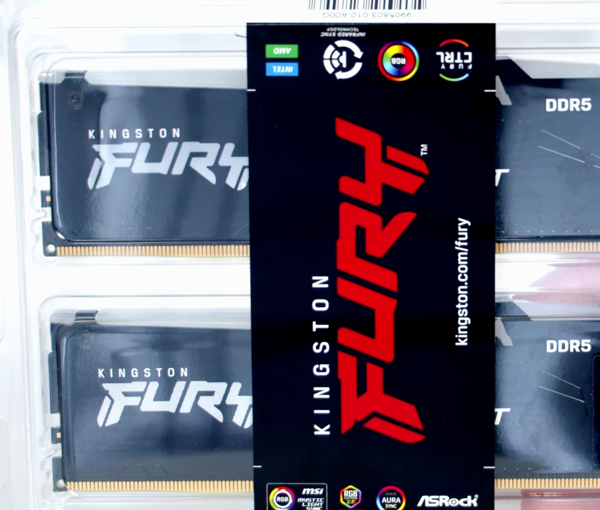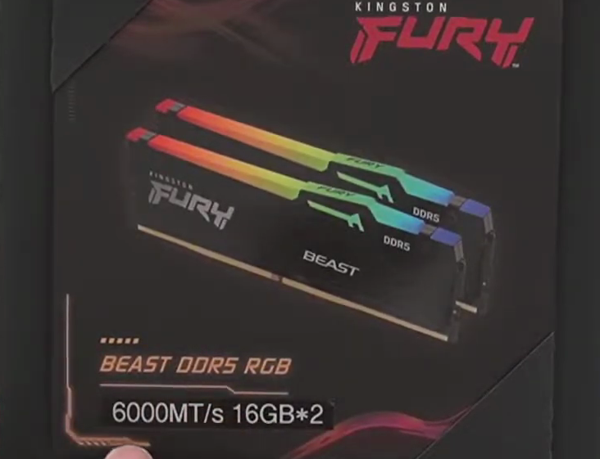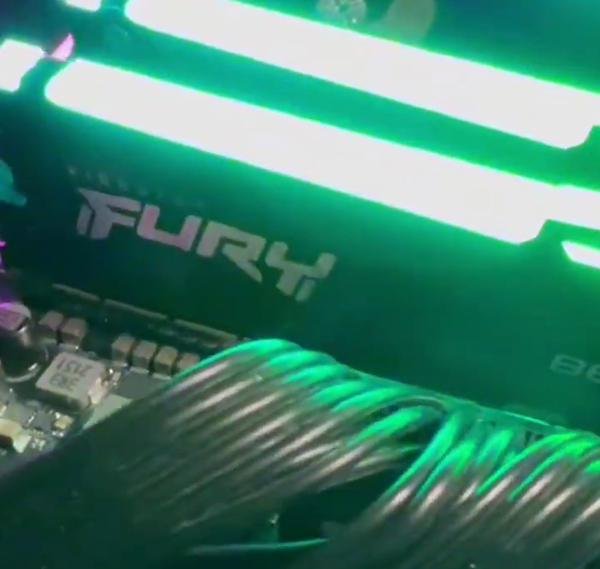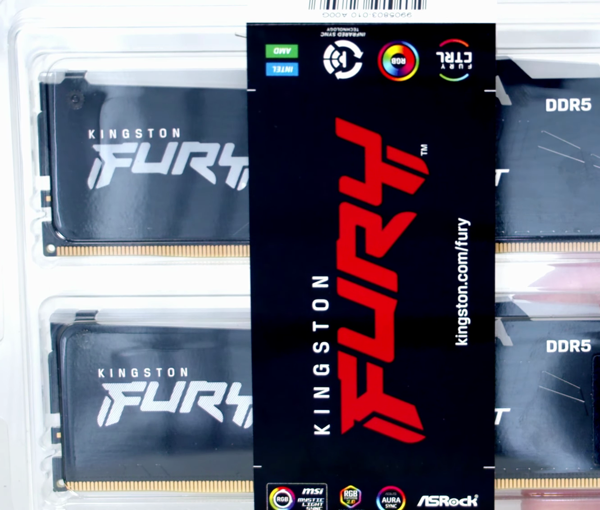Note: As an Amazon Associate we earn from qualifying purchases.
Review: Trying out the Kingston Fury Beast 32GB DDR5 4800MT/s CL38 Kit (2024)
Introduction
I have been using the Kingston FURY Beast DDR5 memory (4800 MT/s) for a while now in a new pc build focused on DDR5 memory. I was curious to see if upgrading to DDR5 would lead to a noticeable improvement for both gaming and work tasks. It quite did, and the advanced features, such as on-die ECC and Intel’s XMP 3.0 overclocking capabilities, are great as well.
Specifications
| Property | Value | Property | Value |
|---|---|---|---|
| Brand | Kingston Technology | Computer Memory Size | 32 GB |
| RAM Memory Technology | DDR5 | Memory Speed | 4800 MHz |
| Compatible Devices | Desktop |
Photos
Click on photos to enlarge them:
Prices
Check prices of the Kingston Fury Beast DDR5 32GB Kit Black on:
Initial Impressions and Setup

When I first heard about the Kingston FURY Beast DDR5 memory, my curiosity was piqued by its promise of leveraging cutting-edge technology for next-gen gaming platforms. The enhanced features such as on-die ECC (ODECC) and dual 32-bit subchannels signaled a step up from previous memory standards, and the Intel XMP 3.0 readiness was a cherry on top for someone interested in overclocking.
My initial setup experience was mostly straightforward. Upon enabling the XMP in my ASUS BIOS, the DDR5’s 4800MHz speed kicked in without a hitch. It felt satisfying to see my system’s performance align with the advertised speeds, especially when pairing it with my ASUS Prime Z690-P motherboard and Intel Core i7-12700KF processor. The plug-and-play functionality at 4800MT/s exemplified the memory’s user-friendly approach.
However, it wasn’t all smooth sailing. A friend encountered a hiccup when they mistakenly ordered ECC RAM for a non-ECC supported motherboard. It was a reminder that careful compatibility checks are crucial before making any hardware upgrades. As for my experience with installation, it was hassle-free. The low-profile heat spreader design not only blended seamlessly with my setup but efficiently dissipated heat during intensive gaming sessions.
Here’s a quick summary of my thoughts: Pros:
Impressive speed increase (50% faster than DDR4).
On-die ECC and PMIC contribute to stability at high speeds.
Ready for overclocking with Intel XMP 3.0.
Efficient heat spreader design. Cons:
Compatibility issues can arise if not thoroughly researched.
Price can be a factor for those budget-conscious.
Encountering just 20-30 percent memory usage across multitasking scenarios affirmed the 32GB capacity offered by this DDR5 memory. Its robust handling of demanding applications was evident and the setup reinforced the notion that I was getting what I paid for, although the investment was notably steeper when compared to DDR4 options.
Despite the cost, my computer now feels future-proofed, thanks to the Kingston FURY Beast DDR5. The performance I’ve witnessed in gaming and multitasking has cemented my belief in the product. True, I did hear about a bad stick in a pair from another user, but in my case, the quality and reliability shone through with no DOA issues. It’s a comforting thought knowing that each module has been tested and approved; it gives me the confidence to recommend this RAM to others looking to make a similar upgrade, provided they are willing to navigate the higher price point.
The Kingston FURY Beast DDR5 has given my system a new lease on life, combining style and substance to deliver a premium computing experience. It’s a significant step forward in memory technology, and while the cost may give some pause, the performance gains are tangible.
Performance and Overclocking

In the realm of high-performance computing, the Kingston FURY Beast DDR5 memory is a significant step forward from its predecessors. With increased demands from gaming and professional applications, DDR5 technology presents substantial improvements:
Greater Speed: The jump to DDR5 undoubtedly means more bandwidth. The starting speed at 4800MHz is about 50% faster compared to DDR4, which translates to my games and applications running smoother than ever.
Enhanced Capacity: Doubling up the banks and burst length seemed like overkill at first, but in practice, it gives me that extra headroom for multitasking without a hitch.
Improved Efficiency: Due to the dual 32-bit subchannels, my system’s ability to handle data has noticeably sharpened, especially when dealing with demanding tasks.
On-die ECC (ODECC) is another aspect that caught my attention. It’s not something I’ve always considered essential, but knowing that it works silently to maintain data integrity and system stability while I’m overclocking or running heavy applications is reassuring. And the inclusion of Intel XMP 3.0 brings an easier overclocking experience, with its two customizable profiles providing adaptability for either aggressive performance or stability-focused tuning.
However, it hasn’t all been smooth sailing. The advanced features like programmable PMIC make overclocking more accessible, but it does come with a learning curve. Not to mention, the price point is on the higher side, although the performance gains can justify the cost for enthusiasts and professionals alike.
Installation was a breeze; it was truly a plug-and-play experience at 4800MT/s. The low-profile heat spreader design meant I didn’t have to worry about clearance issues with my CPU cooler, which is often a concern with high-profile modules.
One slight niggle was that I had to enable the XMP profile in the BIOS to ensure the RAM was running at the advertised speeds, which might not be obvious to less experienced builders. There’s also the dependency on compatible hardware; not all motherboards and CPUs can harness the full potential of DDR5 just yet.
Here’s a summarizing bullet point rundown of the Kingston FURY Beast DDR5:
Pros:
Remarkably fast.
Improved multitasking capabilities.
On-die ECC for added stability.
Intel XMP 3.0 ready, with easy overclocking.
Low profile design fits well in most builds.
Cons:
Pricey for memory.
Requires XMP to be enabled for optimal performance.
Dependent on having DDR5-compatible hardware.
Working with the Kingston FURY Beast DDR5 memory has been largely positive for me. It gave my system a significant boost and has mostly lived up to the hype, aside from a couple of manageable quirks. It’s been an essential component for staying ahead in the ever-evolving tech landscape.
Stability and Compatibility

When choosing RAM for a high-performance PC build, stability, and compatibility are paramount. I recently had the chance to test out the Kingston FURY Beast DDR5 memory, and here’s what stood out to me regarding these aspects:
Improved Stability for Overclocking: The inclusion of on-die ECC (ODECC) is a game-changer. While overclocking, it maintains data integrity and prevents errors. This has provided a noticeable increase in stability while tweaking the system to get every ounce of performance.
Increased Efficiency: The dual 32-bit subchannels are designed to handle data more efficiently, which I found beneficial when multitasking or running memory-intensive applications.
Compatibility: The Intel XMP 3.0-Ready certification gave me peace of mind, knowing the RAM would work well with my motherboard and could take advantage of enhanced performance profiles.
Ease of Use: A low-profile heat spreader design means it fits easily into builds, even with larger CPU coolers. The Plug N Play feature at 4800MT/s was particularly user-friendly, enabling the RAM to run at optimal speeds without manual tweaks.
One notable drawback I experienced was the initial confusion around technical specifications. This is not a reflection on Kingston’s product but a reminder to ensure your motherboard supports the specific type of RAM you’re purchasing. For instance, not all systems support ECC RAM, and that can lead to compatibility issues.
On another note, while everything ran smoothly, a friend pointed out that one of their RAM sticks was DOA, and they had to get it replaced. It’s worth noting that while quality control is generally excellent, always check your components upon arrival.
From my use, whether running high-resolution video editing software, gaming at max settings, or operating multiple demanding applications simultaneously, the Kingston FURY Beast DDR5 delivers. Especially when paired with the right processor, such as the Intel Core i7-12700KF, you can feel the difference in smoothness and response time.
For anyone aiming to stay on the cutting edge of technology with a reliable memory module that can handle a range of tasks without breaking a sweat, Kingston’s DDR5 RAM fits the bill. It’s comforting to have a system that doesn’t struggle with resource demands, particularly when you’re nearing only 20-30 percent memory usage with several operations ongoing.
In summary, while flying past DDR4 speeds by a significant margin, and making multitasking a breeze, the Kingston FURY Beast DDR5 settles comfortably into its role as a reliable and compatible choice for any modern build, provided you’ve checked compatibility specifics of your motherboard. This RAM has my vote for anyone looking to make their system not only current but prepared for whatever the future might throw at it.
Value and Future Proofing

In the fast-paced world of tech, staying ahead of the curve often comes with a premium cost but aims to offer that elusive blend of performance and future-proofing. With the Kingston FURY Beast DDR5, there’s a sense of investing not just in immediate gains but in longevity as well. Here’s a rundown from my experience:
Speed and Capacity: With a start at 4800MHz, it’s a noticeable jump from DDR4 and facilitates multitasking with ease.
Efficiency: The dual 32-bit subchannels enhance data handling, meaning a smoother experience in both gaming and heavy applications.
Stability: On-die ECC is a boon for overclockers, promoting data integrity even when pushing the system’s limits.
Heat Management: The low-profile heat spreader efficiently sates thermal concerns, ensuring consistent performance.
Customization: Intel XMP 3.0 compatibility means I can fine-tune settings to get the most from the memory.
However, not everything is plain sailing. The premium for DDR5 might be a sticking point for some, and initial motherboard compatibility hitches, as others have noted, can take the shine off the experience. Plus, there’s the ever-present risk of DOA components, a reality of hardware upgrades. Thankfully, that wasn’t my personal experience.
Beyond the hard stats, there’s a tangible sense of “future-proofing.” I paired the Kingston FURY Beast DDR5 with an ASUS Prime Z690-P and an Intel Core i7-12700KF processor, managing to hit the claimed 4800 MHz smoothly after enabling XMP - a result that left me nodding in satisfaction. The notion of “future-proofing” isn’t just a marketing phrase in this case; it’s about ensuring that the system can handle upcoming software and game requirements.
For those worrying about heat, the efficient low-profile heat spreader design isn’t just for show. It kept temperatures in check during intense gaming and 3D rendering sessions, which speaks volumes about the design’s practicality.
When considering if the investment is worth it, the 32 GB capacity strikes a fine balance between overkill and necessity. In real-world terms, it translates to me having multitude programs running simultaneously without a hitch. I haven’t faced any issues with installation or during operation; it worked perfectly out of the box.
In essence, the Kingston FURY Beast DDR5 memory might be on the pricier side, but the price tag is justified by its robust performance and the promise of durability down the road. For those building workstations or gaming rigs with the future in mind, this memory meets the brief. If one can reconcile with the investment, the returns in terms of efficiency, speed, and stability might just make it a savvy move for an enthusiast.



